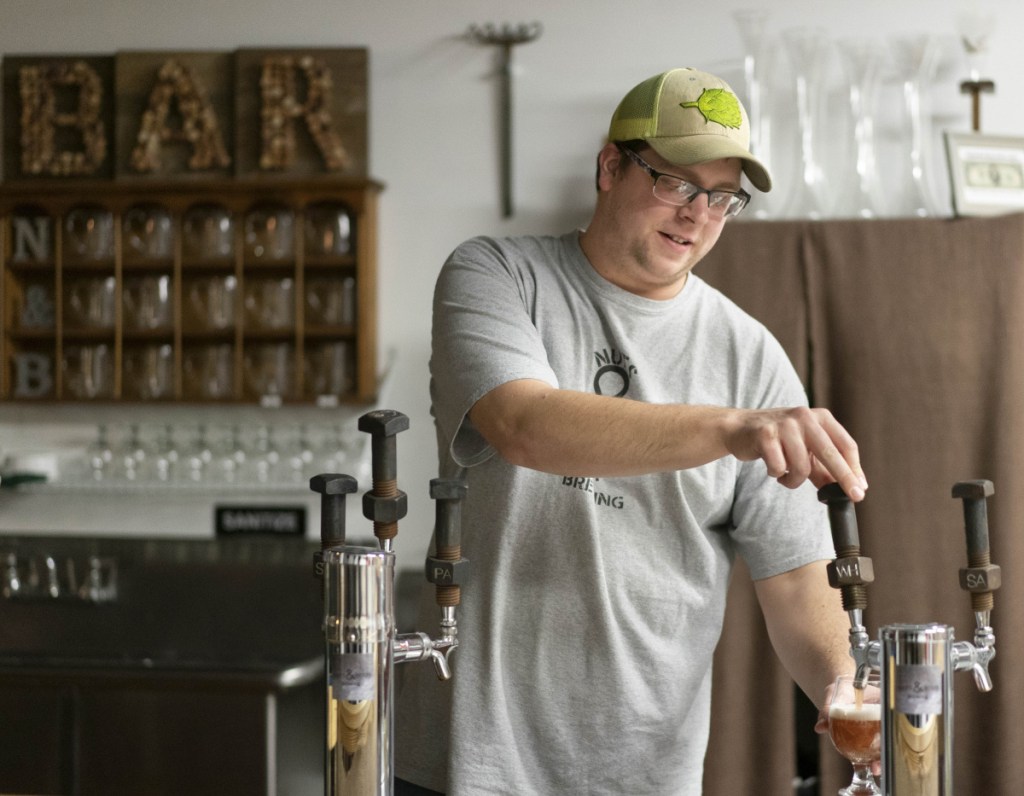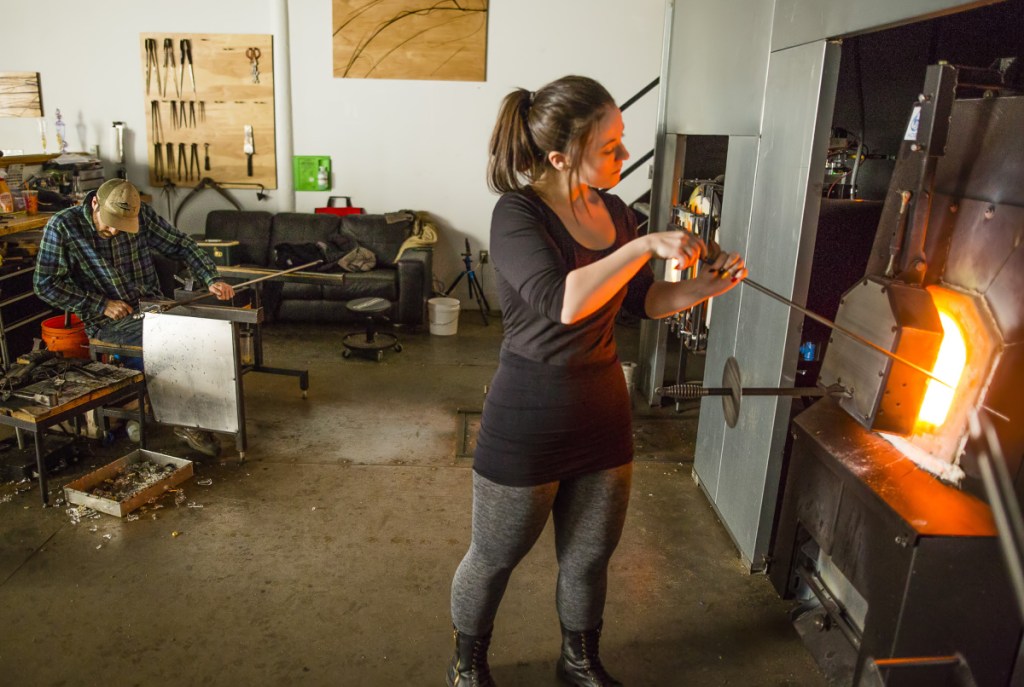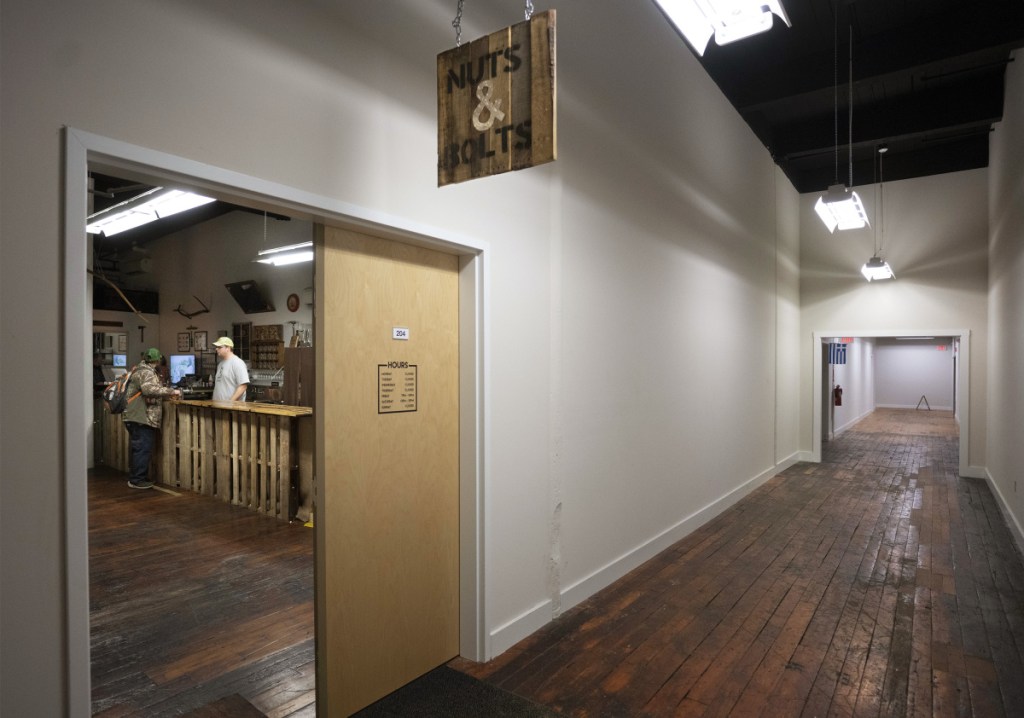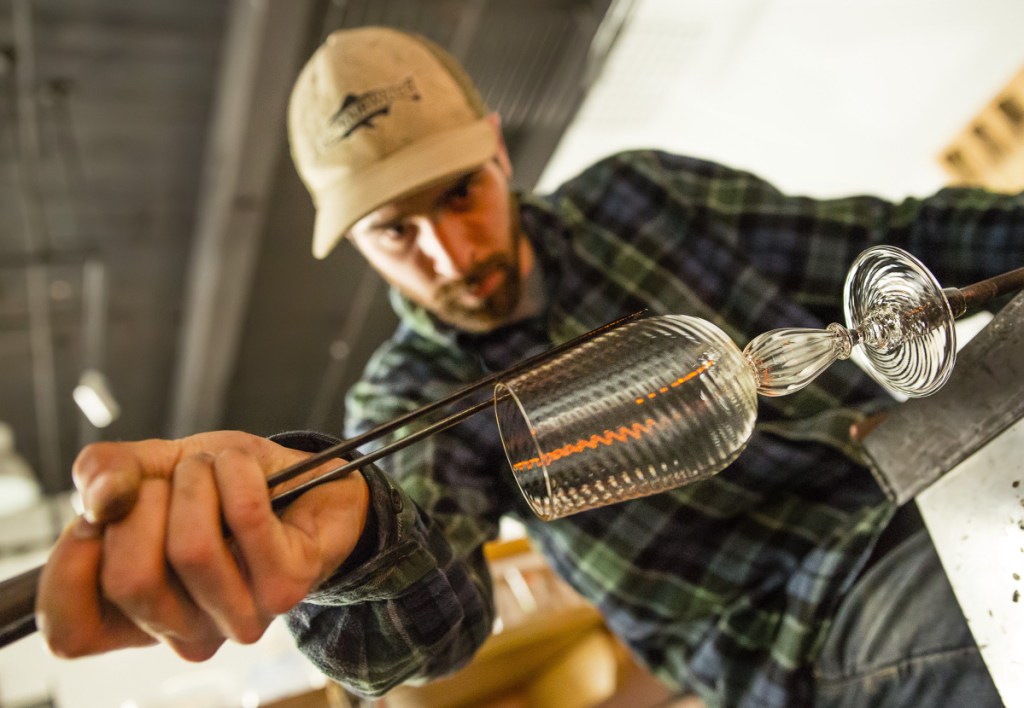BIDDEFORD — Patrick Doherty frequently finds himself telling people Biddeford isn’t what it used to be.
From behind the bar at his brewery, Nuts & Bolts Brewing, the 27-year-old Biddeford native serves beer to millennials who live in the city’s former textile mills, recommends restaurants that have opened up downtown and finds ways to collaborate with other small-business owners.
“I remember when I was growing up there was a ‘for lease’ sign in every store on Main Street,” Doherty said. “Now it’s difficult to find space.”
Doherty is among a growing number of people in their 20s and 30s moving to Biddeford, drawn by available and affordable space, the urban feel and the increasingly vibrant downtown atmosphere and nightlife.
Biddeford is now the youngest city in Maine. The median age of all residents is 35, and it’s just 29 in the city’s downtown area. More than a quarter of the city’s 21,400 residents are between the ages of 20 and 34. Since 2013, the city has seen a 22 percent increase in the number of residents between 20 and 24, and a nearly 38 percent increase in people ages 25 to 34, according to Census population estimates.
City officials say those young people have helped reshape Biddeford’s identity. They have brought with them new businesses and jobs and an energy that is helping stoke excitement about the future of a city that struggled after the departure of textile manufacturing, which once drove the local economy.
“Biddeford has always been stereotyped as an old city. It’s always been the mémères and the pépères,” Mayor Alan Casavant said. “I think that dominated the political and economic landscape for a long time. What’s happened in the last few years, I don’t think anyone saw coming.”
A decade ago, the last vestige of the city’s long textile history closed, leaving empty the towering brick mill buildings where thousands of Biddeford residents once worked. The downtown, dotted with empty storefronts, was far from the bustling Main Street where shops and restaurants once catered to millworkers. A trash incinerator operated blocks from Main Street on the banks of the Saco River.
In 2012, the city bought and tore down that trash incinerator, ushering in a new phase of redevelopment that has generated millions of dollars of investment, according to city officials. The number of jobs in the mill district jumped 450 percent from 2014 to 2018.
And a lot of young people followed.
Katie Oliver, a 29-year-old color specialist at Tulu Salon & Spa, moved to Biddeford from Portland two years ago, attracted by the less expensive housing and the new businesses opening downtown.
“That the median age (downtown) is 29 speaks volumes about what’s happening here. There are so many young people flocking to this area,” Oliver said while having a drink with friends at Elements, a coffee shop and bar that also is a bookstore. “There’s always something going on. I think the energy is really fast.”
But that redevelopment and excitement – Casvant calls it the “Biddesance” – hasn’t come without growing pains. Some residents pushed back against a new parking management plan that involves fees to park in municipal lots. And there is growing concern from city and school officials about longtime residents and young families being priced out of the city. The average rent of a two-bedroom apartment has increased sharply in the past three years, from $835 to $1,305 a month. The median home price in Biddeford rose from $179,900 in 2013 to $234,900 in 2017.
“Things look a lot different in this city than anybody would have thought five years ago,” said Chris Indorf, the assistant superintendent of schools.
ONCE DEFINED BY ITS MILLS
Biddeford was incorporated in 1718 and by the 1850s had a textile manufacturing industry in full swing. Waves of immigrants – first the Irish, then French Canadians and eastern Europeans – came to the city to work. The textiles made in the York, Laconia and Pepperell mills were shipped all over the world.
The three mills together employed 3,500 people, operated 70 boardinghouses and produced more than 25 million yards of cotton fabric each year, according to the Maine Historical Society. Downtown shops sold everything from fresh fruit to fancy silks. Some 600 stores and houses were built in less than a decade in the mid-19th century.
By 1880, the population of Biddeford had grown to 12,652. Half of the residents were foreign-born.
The available jobs with nearby housing drew thousands of young people from Quebec to Biddeford. Even today, many Biddeford families speak French and celebrate their Franco-American heritage with an annual festival.
For more than a century, the textile manufacturing industry was robust. But in the 1950s, the mills began to close as manufacturers found cheaper production costs in Southern states. In 2009, WestPoint Home shut its doors, ending more than 175 years of textile manufacturing in Biddeford.
“I think Biddeford has always been defined by the mills, those big brick monoliths that really not only dominated the geographical landscape, but also dominated the economy for years because so many people worked there,” Casavant said.
The mills, empty of the large looms and machines once running around the clock, wouldn’t sit idle for long.
BUYING, CLOSING INCINERATOR
When 26-year-old Ryan Fecteau graduated from Biddeford High School in 2010, he had little reason to go downtown. A few of the city’s mainstays – Pizza By Alex, George’s Sandwich Shop, New Morning Natural Foods and Reilly’s Bakery – still attracted loyal customers, but there wasn’t much else to see.
“It didn’t feel like a place you’d want to visit,” he said, recalling the one small coffee shop on Main Street at the time.
But behind the brick walls of the former Pepperell Mills, developer Doug Sanford and his team were laying the groundwork for a transformation of the mill campus. They first redeveloped North Dam Mill into a mixed-use space with small businesses, artist studios and apartments. The apartments, with exposed brick and original wood floors, began to bring tenants in from outside Biddeford. As rents in Portland rose, hundreds of people put their name on a waitlist for apartments in the mill.
Sanford bought the rest of the 1-million-square-foot Pepperell Mill campus in 2010.
Two years later, in a decision the mayor credits with changing the dynamic of the city, the City Council voted to buy and close Maine Energy, the trash incinerator that had operated downtown for three decades.
Developers took notice. Within six years, more than $100 million in new investment in downtown projects was announced. Other mill buildings were renovated into apartment buildings, with more than 400 apartments built, planned or proposed since 2010. This spring, the Pepperell Mill Campus will add 51 new apartments, bringing its total number of residential units to 151.
Businesses – ranging from retail shops to commercial bakeries to light manufacturing – moved into the mill complex and downtown storefronts. New restaurants and shops opened along Main and Alfred streets.
Between 2014 and 2018, jobs in the mill district increased by 450 percent, from 95 to 530. Overall, jobs in the mill district and downtown area grew by 45 percent during that time, according to City Manager James Bennett. The Pepperell Mill Campus now houses 121 businesses that employ more than 500 people.
“Biddeford has been off the economic grid for a lot of people for a long time. Once the mills folded up and went south, I think people forgot about Biddeford,” Casavant said. “What has happened since the closure of Maine Energy is that entrepreneurs have been willing to take a gamble here because they recognize there is a market here if you have the right product and the right niche.”
‘A MILLION PEOPLE MY AGE’
Joseph Webster, 27, grew up in Portland and went to college in Boston. After graduate school, the glass blower was looking to come back to Maine to live and open a studio. He felt Portland had lost the small-town feel he loved growing up there. Plus it was expensive.
Webster found a home – both for himself and his studio – on the Pepperell Mill Campus. His studio is a roughly 1,300-square-foot space across the hall from the Eventide commissary kitchen and around the corner from Nuts & Bolts Brewing. Webster, who specializes in Venetian-style glass pieces, lives in the North Dam Mill.
“I never thought I’d ever be here,” he said. “It wasn’t really on my radar. I thought of it similarly to Westbrook, a little rundown.”
Webster said that while he was originally drawn to Biddeford by affordable rental space, he has come to appreciate its atmosphere and proximity to the outdoors and other cities.
“Living here now is a want more than a need,” he said. “It has that small-town vibe Portland had 10 years ago when I was growing up.”
Webster is not at all surprised that Biddeford is now the youngest city in Maine. Many of his neighbors in the mill are his age and more people in their 20s and 30s move in each month, he said. It’s not uncommon for him to run into people his age in the coffee shops, restaurants, breweries and distilleries that operate throughout the mills and across the downtown.
Amy Clearwater, a 34-year-old member of the City Council, sees the same thing.
“There are a million people my age,” she said.
Clearwater, who was appointed to the council last year, is among the young Biddeford residents getting involved in politics at the city and state level.
The city’s delegation at the State House includes Fecteau and Rep. Victoria Foley, who was 35 when she was elected last year after serving on the City Council. Fecteau was one of the Legislature’s youngest members when he was elected at 22 years old and now, at 26, is the House assistant majority leader,
Clearwater moved to Biddeford from Portland in 2017 when she and her wife, Alexa Potkin, bought a house on Alfred Street, just a few blocks off Main Street. They were able to buy an affordable house with an accessory unit for her mother, and loved the idea of living in a walkable downtown they consider safe and fun, she said.
“There’s a great community here of young people doing creative and interesting things,” Clearwater said. “It felt like a great opportunity to be part of something.”
CATCH-22 OF GENTRIFICATION
While she is excited about all of the new businesses and activity in the city, Clearwater is keenly aware of the impact the changes are having on Biddeford residents. She said the city needs an economically diverse downtown to continue its success and that local government should work to prevent people from being displaced by growth.
“We cannot lose sight of what has brought Biddeford to where it is now, which is the people who have been here for the better part of their lives,” Clearwater said.
Bennett, the city manager, said one of the biggest challenges Biddeford currently faces is housing affordability and rising rents. The City Council in recent weeks has started having informal discussions about workforce and market rate housing.
“We have lifelong residents in the community who have been renting who are now finding they can’t keep up with the increases,” Bennett said. “They don’t want to leave.”
Fecteau, a Democrat, said he is “tremendously concerned” about affordable housing, which is not an issue unique to Biddeford. He is sponsoring a bill that would provide state income tax breaks to trigger investment in new low-income housing projects, an incentive proponents say is crucial to easing Maine’s affordable housing crisis.
“You have folks who have lived in Biddeford for many decades and stuck it out through the bad times, the mill closures and the recessions,” Fecteau said. “They’ve been there and in many cases they’ve been primary contributors to our revitalization. Now they’re feeling the pinch. This is the Catch-22 of downtown development and gentrification.”
School officials are seeing that same pressure on families struggling to stay in apartments they can no longer afford or who find themselves homeless after being evicted. Indorf, the assistant superintendent, said the school department now knows of 47 students who are temporarily homeless or transient.
Jeremy Ray, the superintendent of Biddeford schools, says there is no doubt the age shift in the city is affecting the school department in a variety of ways. Enrollment is down to about 2,400 students from close to 2,800 in 2008, although enrollment could rise again in coming years as young couples start to have children.
“As the city becomes younger, we’re seeing a slight downturn in enrollment,” he said. “We believe that a lot of that is because many of the apartments that traditionally had families living in them just don’t anymore.”
Bennett said city staff is watching closely the shifting demographics in Biddeford and taking those changes into account as they plan for the future. In the short term, the city is also learning to communicate in new ways, he said. Instead of posting notices about meetings and hearings in newspaper ads or on bulletin boards, city staffers are more likely now to turn to social media to reach out to residents.
The city is also increasingly using social media and its website to highlight what’s changing in Biddeford.
“We’ve had to walk ourselves out of the 19th century way of trying to communicate with people about what’s going on,” Bennett said.
HOW FUTURE ECHOES THE PAST
On the first Friday night in March, Main Street was lined with cars as people, bundled against the cold, walked in pairs and small groups to Elements, the popular coffee shop-bookstore-bar across from the public library. Inside, it was standing room only as the band Micromassé performed to celebrate Elements’ sixth anniversary.
Elements co-owner Katie Pinard weaved her way through the crowd, stopping to say hello to couples sitting at tables and a group of 20-somethings crowded around the bar. Six years ago, when Elements opened at the opposite end of Main Street from the mill complex, people still openly referred to Biddeford as “Trashtown USA.”
“It’s time we got rid of that reputation,” said Pinard, who graduated from Biddeford High School in 1998.
In the past six years, Pinard has seen a distinct shift toward a vibrant downtown like the one she heard about in stories of her grandmother’s youth. As a kid, Pinard would go downtown with her mom to buy sewing thread at Doyon Pharmacy or shop in the shoe store on Main Street. But by the time she was a teenager, she only went downtown to do research at McArthur Library.
“There was a sense of vitality that was really lost when I was in high school,” she said.
Now 39, Pinard feels a sense of purpose being involved in the revitalization of the city. Elements has become a multi-generational gathering spot that many in the community felt had been missing, she said. And Pinard is excited about the other new businesses that people in their 20s and 30s have opened in the city.
“They’re taking risks and establishing businesses we historically would have said would never make it here,” Pinard said, noting the food producers moving to Biddeford.
Doherty, from Nuts & Bolts Brewing, believes the food and drinks produced in Biddeford are bringing more people to the city and keeping them there.
“You don’t have to go to Portland to grab a craft beer or a craft cocktail,” said Doherty, who runs the brewery with his partner, Deedra Zeeh. “There are awesome little foodie spots here. Instead of traveling to Portland to wait for a seat, you can just head downtown for awesome food.”
Doherty thinks that new, youthful energy infusing the city has put Biddeford’s downtown on track to be the next Old Port.
“I think people are ready to give it a second chance,” he said. “It’s the next big thing.”
Send questions/comments to the editors.









Comments are no longer available on this story